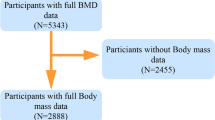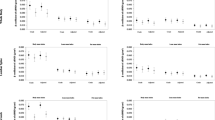Abstract
Summary
The relationship of body composition and bone mineral density is complex and controversial. When classifying Korean population based on gender, age, and body mass index, fat mass had varying contributions to bone mineral density.
Introduction
The relationship between body composition and bone mineral density (BMD) is complex, and it is uncertain how components of body mass variably affect BMD.
Methods
This cross-sectional observational study was performed in subjects ≥20 years based on the Korea National Health and Nutrition Examination Survey (KNHANES) 2008 to 2011. Among 17,583 subjects, the mean ages were 49.1 ± 16.0 years (M, n = 7495) and 49.3 ± 16.3 years (F, n = 10,088). Subjects were divided into age groups, either <50 or ≥50 years for males, or menopausal state, either premenopausal or postmenopausal, for females. A further classification used BMI, either <25 or ≥25 kg/m2. Anthropometric and body composition parameters were compared and evaluated to look for correlations with BMD. Further, appendicular lean mass (ALM), fat mass (FM), fat percentage (FP), and waist circumference (WC) were included for multivariate analysis with BMD, controlling for covariates in each age group and BMI subgroup.
Results
Anthropometric and body composition parameters significantly correlated with BMD in all age groups for both genders. After adjusting for covariates, ALM strongly affected BMD in all age groups for both genders. FM, FP, and WC significantly affected BMD in both age groups of women and in older men, but they did not affect BMD in younger men. Fat indices positively affected BMD of all sites in all non-obese women and in non-obese older men. However, little contribution was found in obese subgroups of both genders and in non-obese younger men.
Conclusion
Considering different weights of covariates, ALM strongly contributed to BMD in all gender, age, and BMI groups. On the other hand, fat indices positively affected BMD of both age groups in women and older men with normal BMI, but they showed little contribution to BMD within the same age groups with high BMI or any BMI subgroups of younger men.


Similar content being viewed by others
Abbreviations
- 25OHD:
-
25-Hydroxyvitamin D
- ALM:
-
Appendicular lean mass
- ALT:
-
Alanine aminotransferase
- AST:
-
Aspartate aminotransferase
- BMD:
-
Bone mineral density
- BMI:
-
Body mass index
- DBP:
-
Diastolic blood pressure
- DXA:
-
Dual-energy X-ray absorptiometry
- FM:
-
Fat mass
- FN:
-
Femur neck
- FP:
-
Fat percentage
- FRAX:
-
Fracture Risk Assessment Tool
- LM:
-
Lean mass
- LS:
-
Lumbar spine
- M:
-
Model
- PreM:
-
Premenopausal
- PostM:
-
Postmenopausal
- SBP:
-
Systolic blood pressure
- TH:
-
Total hip
- WC:
-
Waist circumference
References
Reid IR (2002) Relationships among body mass, its components, and bone. Bone 31:547–555
Laet CD, Kanis JA, Oden A, Johanson H, Johnell O, Delmas P, Eisman JA, Kroger H, Fujiwara S, Garnero P, McCloskey EV, Mellstrom D, Melton LJ 3rd, Meunier PJ, Pols HAP, Reeve J, Silman A, Tenenhouse A (2005) Body mass index as a predictor of fracture risk: a meta-analysis. Osteoporos Int 16:1330–1338
Nielson CM, Srikanth P, Orwoll ES (2012) Obesity and fracture in men and women: an epidemiologic perspective. J Bone Miner Res 27(1):1–10
Wellens RI, Roche AF, Khamis HJ, Jackson AS, Pollock ML, Siervogel RM (1996) Relationships between the body mass index and body composition. Obes Res 4(1):35–44
Kanis JA, Hans D, Cooper C, Baim S, Bilezikian JP, Binkley N, Cauley JA, Compston JE, Dawson-Hughes B, El-Hajj Fuleihan G, Johansson H, Leslie WD, Lewiecki EM, Luckey M, Oden A, Papapoulos SE, Poiana C, Rizzoli R, Wahl DA, McCloskey EV, Task Force of the FRAX Initiative (2011) Interpretation and use of FRAX in clinical practice. Osteoporos Int 22(9):2395–2411
Guney E, Kisakol G, Ozgen G, Yilmaz C, Yilmaz R, Kabalak T (2003) Effect of weight loss on bone metabolism: comparison of vertical banded gastroplasty and medical intervention. Obes Surg 13:383–388
Radak TL (2004) Caloric restriction and calcium’s effect on bone metabolism and body composition in overweight and obese premenopausal women. Nutr Rev 62:468–481
Flegal KM, Graubard BI, Williamson DF, Gail MH (2005) Excess deaths associated with underweight, overweight, and obesity. JAMA 293(15):1861–1867
Taaffe DR, Cauley JA, Danielson M, Nevitt MC, Lang TF, Bauer DC, Harris TB (2001) Race and sex effects on the association between muscle strength, soft tissue, and bone mineral density in healthy elders: the Health, Aging, and Body Composition Study. J Bone Miner Res 16:1343–1352
Gnudi S, Sitta E, Fiumi N (2007) Relationship between body composition and bone mineral density in women with and without osteoporosis: relative contribution of lean and fat mass. J Bone Miner Metab 25(5):325–332
Ahn SH, Lee SH, Kim HM, Kim B-J, Koh J-M (2014) Different relationships between body compositions and bone mineral density according to gender and age in Korean populations (KNHANES 2008–2010). J Clin Endocrinol Metab 99:3811–3820
Blain H, Jaussent A, Thomas E, Micallef JP, Dupyu AM, Bernard PL, Mariano-Goulart D, Cristol JP, Sultan C, Rossi M, Picot MC (2010) Appendicular skeletal muscle mass is the strongest independent factor associated with femoral neck bone mineral density in adult and older men. Exp Gerontol 45(9):679–684
Kim B-J, Ahn SH, Kim HM, Lee SH, Koh J-M (2015) Low skeletal muscle mass associates with low femoral neck strength, especially in older Korean women: the Fourth Korea National Health and Nutrition Examination Survey (KNHANES IV). Osteoporos Int 26(2):737–747
Reid IR (2010) Fat and bone. Arch Biochem Biophys 503(1):20–27
Ho-Pham LT, Nguyen UD, Nguyen TV (2014) Association between lean mass, fat mass, and bone mineral density: a meta-analysis. J Clin Endocrinol Metab 99:30–38
Lee EY, Kim D, Kim KM, Kim KJ, Choi HS, Rhee Y, Lim SK (2012) Age-related bone mineral density patterns in Koreans (KNHANES IV). J Clin Endocrinol Metab 97:3310–3318
Korea Centers for Disease Control and Prevention. The Fourth and Fifth Korea National Health and Nutrition Examination Survey (KNHANES IV, V) 2008–2010. Seoul, Korea: Division of Chronic Disease Surveillance, Korea Centers for Disease Control and Prevention
Schoeller DA, Tylavsky FA, Baer DJ, Chumlea WC, Earthman CP, Fuerst T, Harris TB, Heymsfield SB, Horlick M, Lohman TG, Lukaski HC, Shepherd J, Siervogel RM, Borrud LG (2005) QDR 4500A dual-energy X-ray absorptiometer underestimates fat mass in comparison with criterion methods in adults. Am J Clin Nutr 81:1018–1025
Kelly TL, Wilson KE, Heymsfield SB (2009) Dual energy X-ray absorptiometry body composition reference values from NHANES. PLoS ONE 4(9), e7038
Faulkner JA, Larkin LM, Claflin DR, Brooks SV (2007) Age-related changes in the structure and function of skeletal muscles. Clin Exp Pharmacol Physiol 34(11):1091–1096
World Health Organization Western Pacific Region, International Association for the Study of Obesity, and International Obesity Task Force. The Asia-Pacific perspective: redefining obesity and its treatment. Geneva, Switzerland: WHO Western Pacific Region; 2000
Nguyen TV, Howard GM, Kelly PJ, Eisman JA (1998) Bone mass, lean mass, and fat mass: same genes or same environments? Am J Epidemiol 147:3–16
Wang MC, Bachrach LK, Van Loan M, Hudes M, Flegal KM, Crawford PB (2005) The relative contributions of lean tissue mass and fat mass to bone density in young women. Bone 37:474–481
Hsu YH, Venners SA, Terwedow HA, Feng Y, Niu T, Li Z, Laird N, Brain JD, Cummings SR, Bouxsein ML, Rosen CJ, Xu X (2006) Relation of body composition, fat mass, and serum lipids to osteoporotic fractures and bone mineral density in Chinese men and women. Am J Clin Nutr 83(1):146–154
Reid IR, Evans MC, Ames RW (1994) Volumetric bone density of the lumbar spine is related to fat mass but not lean mass in normal postmenopausal women. Osteoporos Int 4:362–367
Gnudi S, Sitta E, Fiumi N (2007) Relationship between body composition and bone mineral density in women with and without osteoporosis: relative contribution of lean and fat mass. J Bone Miner Metab 25:326–332
Wang J, Thornton JC, Russel M, Burastero S, Heymsfield S, Pierson RN Jr (1994) Asians have lower body mass index (BMI) but higher percent body fat than do whites: comparisons of anthropometric measurements. Am J Clin Nutr 60:23–28
Ho-Pham LT, Lai TQ, Nguyen ND, Barrett-Connor E, Nguyen TV (2010) Similarity in percent body fat between white and Vietnamese women: implication for a universal definition of obesity. Obesity (Silver Spring) 18:1242–1246
Ho-Pham LT, Nguyen ND, Lai TQ, Nguyen TV (2010) Contributions of lean mass and fat mass to bone mineral density: a study in postmenopausal women. BMC Musculoskelet Disord 11:59
Wu CH, Yao YJ, Lu FH, Yang YC, Wu JS, Chang CJ (2001) Sex differences of body fat distribution and cardiovascular dysmetabolic factors in old age. Age Ageing 30:331–336
Amrein K, Amrein S, Drexler C, Dimai HP, Dobnig H, Pfeifer K, Tomaschitz A, Pieber TR, Fahrleitner-Palmer A (2012) Sclerostin and its association with physical activity, age, gender, body composition, and bone mineral content in healthy adults. J Clin Endocrinol Metab 97(1):148–154
Sheng Z, Tong D, Ou Y, Zhang Z, Li S, Zhou J, Zhang J, Liao E (2012) Serum sclerostin levels were positively correlated with fat mass and bone mineral density in central south Chinese postmenopausal women. Clin Endocrinol (Oxf) 76(6):797–801
Modder UI, Hoey KA, Admin S, McCready LK, Achenbach SJ, Riggs BL, Melton LJ 3rd, Khosla S (2011) Relation of age, gender, and bone mass to circulating sclerostin levels in women and men. J Bone Miner Res 26(2):373–379
Urano T, Shiraki M, Ouchi Y, Inoue S (2012) Association of circulating sclerostin levels with fat mass and metabolic disease-related markers in Japanese postmenopausal women. J Clin Endocrinol Metab 97(8):E1473–E1477
Pfeilschifter J, Koditz R, Pfohl M, Schatz H (2002) Changes in proinflammatory cytokine activity after menopause. Endocr Rev 23(1):90–119
Naveiras O, Nardi V, Wenzel PL, Hauschka PV, Fahey F, Daley GQ (2009) Bone-marrow adipocytes as negative regulators of the haematopoietic microenvironment. Nature 460(7252):259–263
Anandacoomarasamy A, Fransen M, March L (2009) Obesity and the musculoskeletal system. Curr Opin Rheumatol 21(1):71–77
Acknowledgments
The authors wish to acknowledge the Korea Centers for Disease Control and Prevention, who performed the KNHANES. This work was supported by research fund of Catholic Kwandong University (CKURF-201601340001).
Author information
Authors and Affiliations
Corresponding author
Ethics declarations
Conflicts of interest
None.
Funding/Support
None.
Electronic supplementary material
Below is the link to the electronic supplementary material.
ESM 1
(JPG 41 kb)
Rights and permissions
About this article
Cite this article
Kim, Y.M., Kim, S.H., Kim, S. et al. Variations in fat mass contribution to bone mineral density by gender, age, and body mass index: the Korea National Health and Nutrition Examination Survey (KNHANES) 2008–2011. Osteoporos Int 27, 2543–2554 (2016). https://doi.org/10.1007/s00198-016-3566-y
Received:
Accepted:
Published:
Issue Date:
DOI: https://doi.org/10.1007/s00198-016-3566-y




